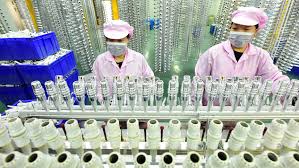Beijing, November 14: China’s economy stumbled in October as factory output and retail sales grew at their weakest pace in more than a year, underscoring mounting pressure on policymakers to revive momentum amid a bruising trade war with U.S. President Donald Trump and persistent weakness in domestic demand.
Industrial production rose 4.9% year-on-year, National Bureau of Statistics (NBS) data showed on Friday, easing sharply from September’s 6.5% increase and missing analysts’ expectations of 5.5%. Retail sales grew just 2.9%, slowing from 3% in September and marking their weakest pace since August 2024.
Economists said the latest data pointed to deepening strains in the world’s second-largest economy, leaving policymakers with limited room to rely on traditional growth engines such as exports or infrastructure spending.
“China’s economy is facing pressures from all sides,” said Fred Neumann, chief Asia economist at HSBC. “The strong lift from exports will be hard to sustain into next year… without significant further stimulus, it will be hard to reverse slowing investment and consumption.”
Weak demand, fading stimulus
Beijing has acknowledged that structural reforms are needed to address long-standing supply-demand imbalances, lift household consumption and curb heavy local government debt. But officials also warned that the external environment remains “fraught with instability and uncertainty”.
China’s exports unexpectedly slumped in October despite months of front-loading by manufacturers bracing for Trump’s tariff measures. Car sales also declined, ending an eight-month growth streak even as buyers were expected to rush purchases before the expiry of tax incentives and subsidies.
The subdued retail figures were partially supported by the extended Singles’ Day shopping festival. But economists said muted sentiment suggested deepening caution among consumers.
“The loss of momentum is disappointing,” said Lynn Song, chief economist for Greater China at ING, adding that the end of China’s trade-in subsidy scheme contributed to weaker spending. “A new policy direction will likely be needed to support consumption next year.”
Investment contracts, property slump persists
Fixed-asset investment fell 1.7% in the January–October period from a year earlier, far worse than the 0.8% drop expected and a deeper decline than the 0.5% fall recorded in the first nine months of 2025. Analysts noted that much of the remaining support is coming from state-owned enterprises.
“The headline figure is being propped up by state-owned enterprises in infrastructure,” said Yuhan Zhang of the Conference Board.
China’s struggling property sector continued to drag on growth, with new home prices falling at their fastest monthly pace in a year, eroding household wealth and confidence.
Limited stimulus expected
While officials have signalled there is still room for stimulus, economists believe Beijing may avoid major action this year. “Structural issues are dragging down growth,” said Xu Tianchen of the Economist Intelligence Unit. “There remains room for stimulus, but officials would rather reserve it for 2026.”
China would need fourth-quarter growth of about 4.5% to meet its full-year target of 5%, a goal analysts say is still achievable but increasingly dependent on a recovery in domestic demand.
